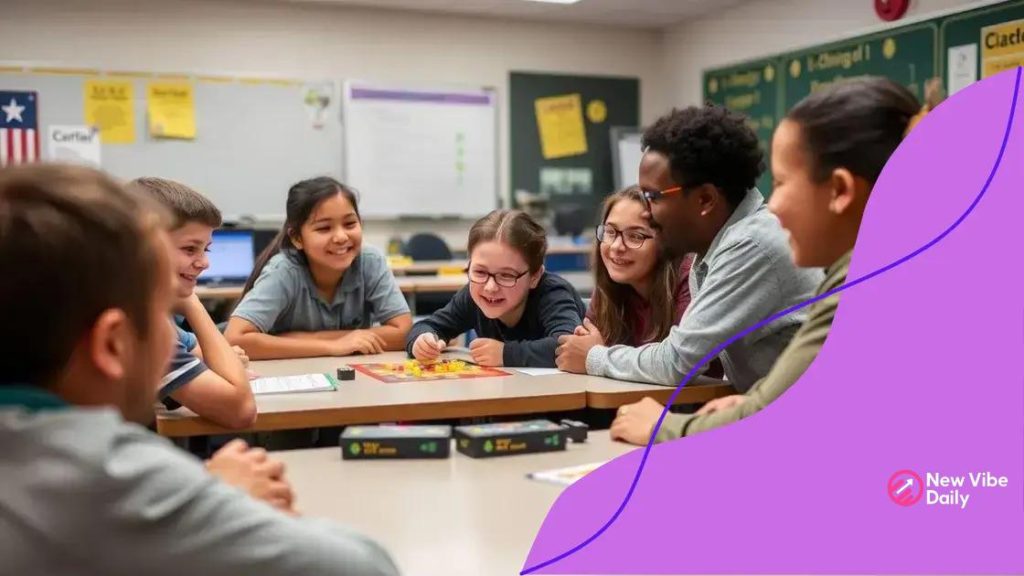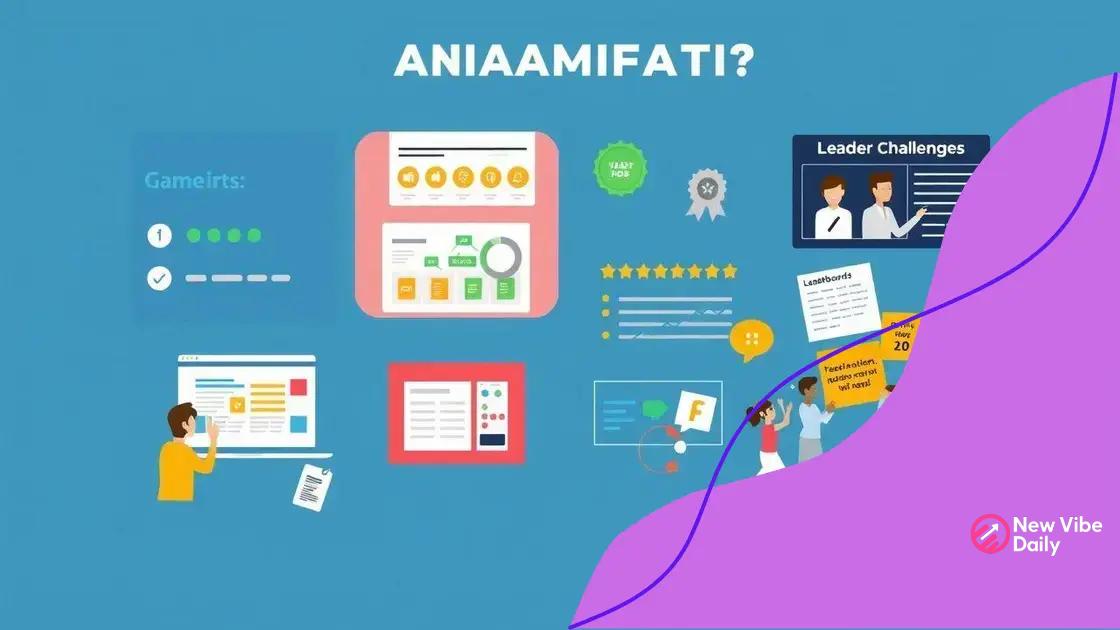Gamification for learning innovations: engaging students effectively

Gamification for learning innovations involves using game elements like points, badges, and competitions to enhance student engagement and improve educational outcomes.
Gamification for learning innovations is transforming how we approach education. Imagine learning through games and interactive experiences! This method not only engages students but also makes learning fun and effective.
Understanding gamification in education
Understanding gamification in education is essential for improving student engagement. Through innovative strategies, educators can turn the learning process into an exciting adventure. This method uses game-like elements to motivate students, making learning interactive.
What is Gamification?
Gamification is the use of game design elements in non-game contexts. In an educational setting, it incorporates elements such as points, badges, and leaderboards to encourage progress. Students are not just passive learners; they become active participants in their education.
Benefits of Gamification in Education
Utilizing gamification can lead to significant benefits. These advantages include:
- Increased motivation: Game mechanics often encourage students to participate more.
- Enhanced retention: When students engage in a fun way, they are more likely to remember what they learn.
- Collaboration: Many gamified activities promote teamwork and communication among peers.
- Immediate feedback: Students receive instant responses to their efforts, helping them improve quickly.
By integrating gamification, educators can create an environment where students thrive. Instead of traditional methods that may seem dull, gamified learning can capture their interest and ignite their passion for knowledge.
Furthermore, gamification encourages a growth mindset. When students face challenges in a game-like environment, they learn to view setbacks as opportunities for improvement. This is a powerful lesson, extending far beyond the classroom.
Incorporating gamification in various subjects can also adapt to different learning styles. Some students may thrive in competitive scenarios, while others excel in collaborative tasks. Educators can tailor experiences, ensuring every student has the chance to succeed.
Ultimately, understanding how to implement gamification is vital. Teachers should be equipped with the tools and knowledge to create meaningful experiences that resonate with their students, transforming ordinary lessons into extraordinary adventures.
Key benefits of gamification
The key benefits of gamification are numerous and impactful, transforming traditional education into a more engaging experience. By incorporating game elements, educators enhance the learning process in exciting ways.
Enhanced Engagement
Engagement is critical in education. When students are captivated by lessons, their motivation increases. Gamification catches their interest through rewards, challenges, and competitions. This boost in enthusiasm can lead to better participation and focus.
Improved Retention
Another significant benefit is improved information retention. When students learn through gamified experiences, they often remember concepts better. The fun and interactive nature helps solidify knowledge, making it easier to recall later.
- Learning through play: Students associate learning with enjoyment, which decreases anxiety.
- Immediate feedback: Gamified systems provide instant responses, reinforcing learning quickly.
- Challenges: Engaging tasks encourage learners to strive for mastery, improving their skills.
Furthermore, gamification fosters collaboration among students. Group activities, where teamwork is essential, create a sense of community. In such an environment, students learn from each other while building social skills.
Gamified systems also cater to various learning styles. Some students might excel in a competitive atmosphere, while others may prefer cooperation. By offering different ways to engage, educators can meet individual needs, enhancing the overall learning experience.
Additionally, setting goals in gamified learning creates a sense of accomplishment. As students complete levels or earn badges, they develop self-discipline and persistence. These skills are invaluable not only in school but also in their future careers.
Ultimately, the key benefits of incorporating gamification in education are profound. Educators who embrace these strategies contribute to a more effective and enjoyable learning environment for their students.
Examples of gamification strategies

There are numerous gamification strategies that educators can implement to enhance learning. Each approach caters to different learning styles and objectives, making education more engaging and effective.
Points and Badges
One of the most popular strategies is the use of points and badges. Students earn points for completing assignments or participating in class. Once they reach a certain point threshold, they receive badges as recognition. This method motivates learners to strive for achievements.
Leaderboards
Another effective strategy is the implementation of leaderboards. Displaying student rankings based on their performance fosters a sense of healthy competition. When students see their names on a leaderboard, they may be inspired to improve their scores, which can lead to increased effort and focus.
- Team challenges: Creating team competitions encourages collaboration and enhances social learning.
- Story-driven activities: Incorporating narrative into lessons can captivate students, turning coursework into an adventure.
- Quests and levels: Designing lessons around quests allows students to progress through levels while mastering concepts at their own pace.
Furthermore, using gamification strategies like interactive quizzes can boost engagement during revision. These quizzes can provide instant feedback and allow students to learn from their mistakes. It makes studying less daunting and more enjoyable.
Additionally, role-playing elements in lessons can create a dynamic classroom atmosphere. By letting students take on different roles, they can experience learning from various perspectives. This approach deepens understanding and nurtures empathy.
Incorporating gamification into blended learning environments is also beneficial. Combining online platforms with face-to-face interactions leads to diverse learning experiences. Students can tackle challenges online, then discuss their strategies in class, merging technology with traditional methods.
Ultimately, the possibilities for gamification strategies are vast. Educators can tailor them to fit their classroom needs, ensuring that each lesson is not only educational but also captivating.
Challenges and solutions in gamification
Implementing gamification in education comes with challenges, but there are effective solutions to overcome these hurdles. Understanding these challenges is key to successfully enhancing the learning experience.
Challenge: Resistance to Change
One common challenge is resistance from students or educators who are accustomed to traditional teaching methods. Some may view gamification as frivolous or unprofessional. To address this, education systems need to communicate the benefits clearly. Training sessions can showcase the effectiveness of gamified approaches, emphasizing how they enhance learning and engagement.
Challenge: Balancing Competition and Collaboration
Another issue is balancing competition among students. While some thrive in competitive environments, others may feel discouraged. It’s important to create a mix of competitive and collaborative activities. Pairing individual achievements with team goals helps ensure that all students feel included and motivated.
- Engagement: Use various gamification elements to cater to different learner types.
- Feedback: Implement regular feedback mechanisms to help students understand their progress.
- Adaptability: Be flexible in your approach, allowing adjustments based on student needs.
Furthermore, ongoing evaluation is critical. Teachers can assess the effectiveness of gamification strategies and make necessary changes. Feedback from students about which elements they enjoy or find beneficial can help refine the approach.
Another challenge is ensuring that technology is accessible to all students. Not every student has the same technological resources. Schools should find ways to integrate gamification without placing financial burdens on students. This can be achieved by utilizing free online tools or providing school resources for those in need.
Additionally, time management can be a struggle when introducing gamified lessons. Educators may feel pressed to cover required curricula while incorporating these interactive strategies. To solve this issue, it’s essential to plan ahead. Integrating gamification into existing lesson plans allows for smooth transitions without sacrificing essential content.
By identifying these challenges and exploring suitable solutions, educators can effectively use gamification to enrich the educational experience, transforming learning into a more exciting journey for students.
Future trends in gamification for learning
Future trends in gamification for learning are poised to change the educational landscape significantly. As technology evolves, so will the methods and strategies used to engage students effectively.
Increased Use of Artificial Intelligence
One exciting trend is the integration of artificial intelligence (AI) in gamification. AI can personalize learning experiences by adapting challenges to each student’s skill level. This creates a tailored educational journey, ensuring that every learner remains engaged.
Virtual and Augmented Reality
Another trend is the use of virtual reality (VR) and augmented reality (AR) in education. These technologies offer immersive experiences that can enhance gamified learning. For example, students can explore historical sites or complex scientific concepts in a 3D environment, making lessons more interactive and memorable.
- Interactive Storytelling: Combining narrative elements with gamification enhances emotional connection.
- Microlearning: Breaking lessons into smaller, digestible units can boost engagement and retention.
- Social Learning: Encouraging collaboration through online platforms will foster community and teamwork.
Moreover, data analytics will play a significant role in the future of gamification. By analyzing student performance data, educators can identify trends and adjust their strategies accordingly. This data-driven approach leads to more effective teaching methods and improved student outcomes.
As educators continue to embrace gamification, the focus will also be on developing emotional intelligence among students. Lessons will increasingly incorporate elements that build empathy, resilience, and teamwork through challenges and collaborative games. This holistic approach to education prepares students for real-world situations.
Furthermore, the rise of remote learning has accelerated the need for innovative gamification strategies. As distance education becomes more prevalent, educators will seek ways to keep students engaged and motivated in a virtual environment. Interactive online tools and gamified learning management systems will become essential resources.
In summary, the future of gamification in education looks promising. With advancements in technology and an increasing focus on personalized learning, these trends have the potential to create exciting and effective learning experiences for students.
FAQ – Frequently Asked Questions about Gamification in Learning
What is gamification in education?
Gamification in education is the use of game elements like points, badges, and challenges to improve student engagement and learning outcomes.
How can gamification enhance student motivation?
Gamification enhances motivation by making learning fun and competitive, encouraging students to participate actively and strive for achievements.
What are some examples of gamification strategies?
Examples include leaderboards, points systems, team challenges, and interactive quizzes that make learning more engaging.
What future trends can we expect in gamification?
Future trends may include the use of artificial intelligence for personalized learning, as well as incorporating virtual and augmented reality in educational settings.






